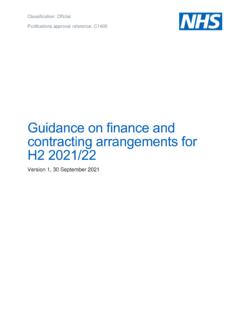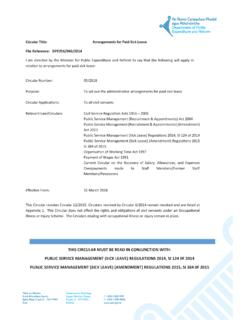Transcription of Guideline: Flexible working arrangements C5
1 Guideline (QH-GDL-242:2019) Guideline for Flexible working arrangements Contents 1 Purpose .. 2 2 What is Flexible work? .. 2 Examples of Flexible work .. 2 3 Why Flexible work? .. 4 4 Creating Flexible workplaces .. 5 Create a Flexible work culture .. 5 Perceived barriers to Flexible work .. 7 Advertising vacancies - Smart Jobs and Careers website .. 8 5 Requests for Flexible work .. 8 Employee s request .. 8 Important information for employees .. 9 Process for the decision maker (delegate).
2 9 Flexible working arrangements Application and Agreement form .. 13 6 Ensuring the arrangements work well .. 14 7 Managing Flexible work by outputs/outcomes .. 16 Related Resources .. 16 Version Control .. 17 Guideline Flexible working arrangements Page 2 of 17 Human Resources Branch Chief Human Resources Officer February 2019 PRINTED COPIES ARE UNCONTROLLED. 1 Purpose This Guideline for Flexible working arrangements (Guideline) should be read in conjunction with the Flexible working arrangements HR Policy C5.
3 Flexible working arrangements are supported by provisions in the Industrial Relations Act 2016 (section 27). This Guideline has been developed as a practical reference tool for employees and managers in relation to Flexible working arrangements , and the information contained within the guideline is intended as a general information source for all employees. 2 What is Flexible work? Flexible work is about where, when and how we work. Access to Flexible working arrangements varies for different categories of employees and needs to be considered within the context of relevant legislation, awards, certified agreements, HR policies and available resources.
4 Not all types of Flexible work will be suitable for all roles or work environments. However, every role is able to be reviewed for even small changes to where, when and how work is performed. Flexible work is not restricted to specific purposes, categories or levels of employees. All employees have the right to request Flexible working arrangements including casual, part-time or contract employees Health Executive Service employees. Examples of Flexible work Flexibility can take many forms and be for many reasons.
5 No one size fits all and every situation is different. Some employees prefer structure and routine, and others work best when they have options to balance competing work and life responsibilities. Managers are encouraged to think proactively about how work can be designed to support Flexible work patterns. Employees are encouraged to discuss requests with management to find the best fit. There are a range of Flexible work possibilities including those in relation to the hours worked, places worked and other arrangements .
6 These options may be adapted and combined, but must be considered in conjunction with relevant industrial provisions. Flexible work options can include, but are not limited to the following: Type Option Description How we work Leave at half pay Accessing long service and recreation leave at half pay can assist in balancing work and life commitments. It is often used to cover school holidays, or to offer greater flexibility for career breaks, carer responsibilities, and travel or study goals. Leave at half pay is subject to delegate approval.
7 How we work Phased retirement Where employees ease out of employment by reducing the number of hours worked, or by changing their responsibilities or employment arrangements . It provides an incentive for employees to delay retirement and Guideline Flexible working arrangements Page 3 of 17 Human Resources Branch Chief Human Resources Officer February 2019 PRINTED COPIES ARE UNCONTROLLED. Type Option Description continue to contribute to the workforce, and can be either a short or long-term arrangement .
8 The key difference between a formal phased retirement situation and the adoption of Flexible working arrangements is phased retirement is often for a pre-determined period prior to formal retirement. It is recommended that employees seek advice to determine potential financial impacts of reducing their number of hours worked per fortnight. How we work Special leave without pay Subject to approval, leave without pay can be used throughout a career for both short and long-term absences or career breaks while providing the security to return to a position at the same level.
9 It is most often used to supplement other leave, such as parental leave, recreation or long service leave. Examples include: Extended leave arrangements can be used to take longer periods of leave. For example, six months of leave to study. Purchased leave extra leave funded by fortnightly deductions from the net salary that occur over a nominated period of time. For example, in a 50/52 arrangement , a person works 46 weeks a year, takes four weeks of normal annual leave, and two weeks of purchased leave.
10 Pay is averaged over the full year so the person receives more leave than usual but a lower annual pay. The minimum period of purchased leave is one calendar week, and the maximum period of purchased leave is six calendar weeks. How we work Transition to retirement Transition to retirement is a way of managing superannuation contributions once a person has reached preservation age. For more information, contact your superannuation provider or financial advisor. When we work Compressed working hours A formal arrangement where normal, full-time hours are worked ( 36 hours 15 minutes or 38 hours per week) over fewer than normal days.

















